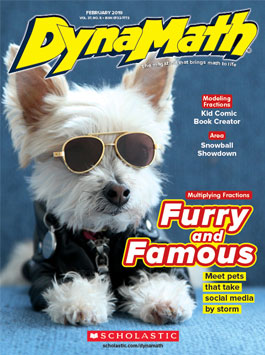If you didn’t make it to NCTM’s annual conference in Washington, D.C., this year, you’re in luck! Between the two of us, we attended 18 presentations given by some of the brightest minds in math education. (Yes, we took a lot of notes!) Here are this year’s top takeaways from the conference.

6 Things We Learned From NCTM 2018
Our favorite takeaways from the yearly math conference
Elizabeth Carney, Executive Editor, (left) and Lauren McCrone, Senior Education Editor, (right)
1. Focus on the WORDS in word problems
When your students encounter a word problem do they think, “I need to give you a number” or “I need to make sense of this situation”? Lynn Girolamo, a district math interventionist in Rochester, NY, calls the former phrase an example of the “Culture of Number Crunching.”
In her talk, she suggested shifting from a mindset of keyword spotting and number picking to a culture of sense making. (Need a refresher about why it’s best to avoid the pitfalls of keywords, see here.)
Girolamo recommends applying literacy strategies to math word problems to build these sense-making skills. She developed the following “Thinking Steps for Solving Word Problems:”
- Think and Picture It (Visualize): What is the story mostly about? What’s the main idea? Describe who is doing what.
- Think About the Details: What do I know from the story? This is where numbers come in—think about the quantities and units.
- Think About the Question: What do I need to figure out from the story? This might require re-reading.
- Do: What can I do to figure out the answer to the question? What equation would match the solution?
- Check: Ask: Does my work make sense? Is my work complete and correct?
With her students, Girolamo specifies, “no pencils for first three steps,” so they focus on thinking and discussing BEFORE computing.
2. Try word problems with no numbers!
In his session, Brian Bushart taught us about the wonderful world of numberless word problems and how to utilize them. This approach is about developing an understanding of the situation rather than focusing on the numbers in the problem.
When using in your classroom, start by covering or removing the numbers of a word problem. Then reveal the information over time. Discuss the question itself last or eliminate it altogether! Remember to allow students to notice and wonder while reasoning about the relationships and quantities along the way.
For tips on how to get started with numberless word problems, check out Bushart’s website.
3. Be precise with math language
Using precise math language is vital to a child’s mathematical understanding. Math words and phrases come in many forms and can be interpreted in different ways. One classroom might have a teacher telling students to “borrow the 1.” Another might say, “carry the 10” or “go next door and borrow ten more!” This creates confusion as students advance grades and change teachers.
To counter this, be consistent and precise with your math language. By using terms such as numerator, sum, and regroup, students will build a library of mathematical vocabulary. This then elicits meaningful discourse in each grade level.
The most powerful advice we heard: Develop a school-wide approach to mathematical vocabulary and use it throughout the building.
4. Ditch the tricks!
Lauren here, and I have a confession: I had CUBES, Rounding Roller Coaster, and Mr. Alligator anchor charts hanging in my classroom when I taught elementary math.
I thought these tricks would help my students remember how to solve problems. But a number of presenters pointed out that these tricks make it harder for students to understand the math that's really happening.
We want students to focus more on visualizing, analyzing, applying correct processes. Not be thinking about what the “s” in sell stands for in the phrase “Does McDonald’s Sell Cheeseburgers Raw?” (And in case you don't know that one, it’s a mnemonic device for remembering the steps of long division.)
By ditching the tricks, students can spend more time thinking and understanding.
5. Include math modeling at any level
Models, drawings, and visual representations are powerful teaching tools in the math classroom, regardless of grade level. To help student make sense of a process or strategy, a visual can be one of your best resources. Picture prompts are a great way to evoke mathematical discussions in which students share their thinking. We can’t assume a child’s background knowledge, so using visual representations can help activate their schema and elicit powerful conversations. Ask them what they notice, what they wonder, and encourage them to reason about the math within it.
6. Math educators love Twitter!
Being surrounded by a group of energetic math educators is always a treat. Especially when everyone is sharing effective math teaching methods.
But this continues beyond NCTM. If you haven’t done so already, check out the math conversations happening on Twitter. #NCTMannual, #MTBoS, and #iteachmath are just a few hashtags that can help catch you up on what you missed and provide you new ideas for the future. Also if you can get your hands on a conference program, there are number of Twitter feeds you can follow.
What did you learn at NCTM? Share your ideas with us by sending us an email!
Want more elementary math education tips and news? Check out Scholastic's archive.
Elizabeth Carney (@BethAnnCarney) is the executive editor of DynaMath and SuperScience, Scholastic’s STEM magazines for elementary school.
Lauren McCrone (@lauren_mccrone) is the senior education editor for Scholastic MATH and DynaMath, two of Scholastic’s STEM magazines.
Recent Posts
-
July 7, 2021
SEL in the Math Classroom: Strategies for Resilience
-
January 30, 2019
Make the Most of DynaMath–With Google Classroom!
-
January 8, 2019
Easy Classroom Updates for 2020
-
December 3, 2019
4 Fun Ways to Use Math Around the Holidays
-
September 10, 2019
Fun Math Icebreaker Activity
Exciting ideas and fun teaching strategies for using DynaMath in 3rd, 4th, and 5th grade math classrooms

